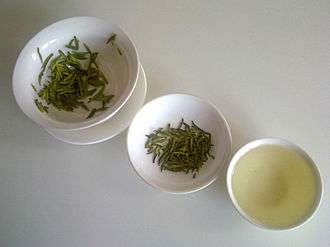Phenolic content in tea

The phenolic content in tea refers to the phenols and polyphenols, natural plant compounds which are found in tea. These chemical compounds affect the flavor and mouthfeel and are speculated to provide potential health benefits. Polyphenols in tea include catechins, theaflavins, tannins, and flavonoids.
Polyphenols found in green tea include but are not limited to epigallocatechin gallate (EGCG), epigallocatechin, epicatechin gallate, and epicatechin; flavanols such as kaempferol, quercetin, and myricitin are also found in green tea.[1]
Catechins

Catechins include epigallocatechin-3-gallate (EGCG), epicatechin (EC), epicatechin-3-gallate (ECg), epigallocatechin (EGC), catechin, and gallocatechin (GC).The content of EGCG is higher in green tea.[2]
Catechins constitute about 25% of the dry mass of a fresh tea leaf,[3] although total catechin content varies widely depending on species, clonal variation, growing location, season, light variation, and altitude. They are present in nearly all teas made from Camellia sinensis, including white tea, green tea, black tea and oolong tea.
Of all the catechins in tea, EGCG is the main subject of scientific study with regard to its potential health effects.[4][5][6][7]
4-Hydroxybenzoic acid, 3,4-dihydroxybenzoic acid (protocatechuic acid), 3-methoxy-4-hydroxy-hippuric acid and 3-methoxy-4-hydroxybenzoic acid (vanillic acid) are the main catechins metabolites found in humans after consumption of green tea infusions.[8]
Theaflavins

Catechin monomer structures are metabolized into dimers theaflavins and oligomers thearubigins with increasing degrees of oxidation of tea leaves.[9] Theaflavins directly contribute to the bitterness and astringency of steeped black tea.[10] The mean amount of theaflavins in a cup of black tea (200 ml) is 12.18 mg.[11]
Three main types of theaflavins are found in black tea, namely theaflavin (TF-1), theaflavin-3-gallate (TF-2), and theaflavin-3,3-digallate (TF-3).[12]
A number of laboratory studies on their possible health effects have been conducted.[13][14]
Tannins
Tannins are astringent, bitter polyphenolic compounds that bind to and precipitate organic compounds. Gallic acid conjugates all of the catechins, such as EGCG (Epigallocatechin gallate), which are tannins with astringent qualities.[15]
Flavonoids
A group of natural phenols called the flavonoids are of popular interest because researchers have found them to have the potential to contribute to better health.[4][5][6][7][16] Tea has one of the highest contents of flavonoids among common food and beverage products.[11] Catechins are the largest type of flavonoids in growing tea leaves.[9] According to a report released by USDA, in a 200-ml cup of tea, the mean total content of flavonoids is 266.68 mg for green tea, and 233.12 mg for black tea.[11]
See also
References
- ↑ Khan N, Mukhtar H (2013). "Tea and health: studies in humans". Current pharmaceutical design (Literature Review). 19 (34): 6141–7. doi:10.2174/1381612811319340008. PMC 4055352
 . PMID 23448443.
. PMID 23448443. - ↑ Thermo Scientific (Dionex) Application Note 275. Sensitive Determination of Catechins in Tea by HPLC . Retrieved 3 August 2013.
- ↑ Balentine DA, Harbowy ME, Graham HN (1998). "Tea: the Plant and its Manufacture; Chemistry and Consumption of the Beverage". In Spiller GA. Caffeine. Boca Raton: CRC Press. p. 35. ISBN 0-8493-2647-8.
- 1 2 Kanwar, Jyoti; Taskeen, Mujtaba; Mohammad, Imthiyaz; Huo, Congde; Chan, Tak Hang; Dou, Qing Ping (2012). "Recent advances on tea polyphenols". Frontiers in Bioscience. 4: 111–31. doi:10.2741/363. PMC 3303150
 . PMID 22201858.
. PMID 22201858. - 1 2 Yang, Chung S.; Lambert, Joshua D.; Sang, Shengmin (2008). "Antioxidative and anti-carcinogenic activities of tea polyphenols". Archives of Toxicology. 83 (1): 11–21. doi:10.1007/s00204-008-0372-0. PMC 2820244
 . PMID 19002670.
. PMID 19002670. - 1 2 Suzuki, Jun-Ichi; Isobe, Mitsuaki; Morishita, Ryuichi; Nagai, Ryozo (2009). "Tea Polyphenols Regulate Key Mediators on Inflammatory Cardiovascular Diseases". Mediators of Inflammation. 2009: 1. doi:10.1155/2009/494928. PMC 2712737
 . PMID 19636434.
. PMID 19636434. - 1 2 Cabrera, Carmen; Artacho, Reyes; Giménez, Rafael (2006). "Beneficial Effects of Green Tea—A Review". Journal of the American College of Nutrition. 25 (2): 79–99. doi:10.1080/07315724.2006.10719518. PMID 16582024.
- ↑ Pietta, P. G.; Simonetti, P.; Gardana, C.; Brusamolino, A.; Morazzoni, P.; Bombardelli, E. (1998). "Catechin metabolites after intake of green tea infusions". BioFactors. 8 (1–2): 111–8. doi:10.1002/biof.5520080119. PMID 9699018.
- 1 2 Peterson, J.; Dwyer, J.; Bhagwat, S.; Haytowitz, D.; Holden, J.; Eldridge, A.L.; Beecher, G.; Aladesanmi, J. (2005). "Major flavonoids in dry tea". Journal of Food Composition and Analysis. 18 (6): 487–501. doi:10.1016/j.jfca.2004.05.006. hdl:10113/7266.
- ↑ US Patent 20110064851 A1 (2011) Method of producing fermented tea drink rich in theaflavins. Google Patents. Retrieved 3 August 2013.
- 1 2 3 U.S. Department of Agriculture, USDA Database for the Flavonoid Content of Selected Foods, Release 2.1, January 2007
- ↑ Del Rio, Daniele; Stewart, Amanda J.; Mullen, William; Burns, Jennifer; Lean, Michael E. J.; Brighenti, Furio; Crozier, Alan (2004). "HPLC-MSnAnalysis of Phenolic Compounds and Purine Alkaloids in Green and Black Tea". Journal of Agricultural and Food Chemistry. 52 (10): 2807–15. doi:10.1021/jf0354848. PMID 15137818.
- ↑ Cameron, Amy R.; Anton, Siobhan; Melville, Laura; Houston, Nicola P.; Dayal, Saurabh; McDougall, Gordon J.; Stewart, Derek; Rena, Graham (2008). "Black tea polyphenols mimic insulin/insulin-like growth factor-1 signalling to the longevity factor FOXO1a". Aging Cell. 7 (1): 69–77. doi:10.1111/j.1474-9726.2007.00353.x. PMID 18005251.
- ↑ Lin, Chih-Li; Huang, Hsiu-Chen; Lin, Jen-Kun (2007). "Theaflavins attenuate hepatic lipid accumulation through activating AMPK in human HepG2 cells". The Journal of Lipid Research. 48 (11): 2334–43. doi:10.1194/jlr.M700128-JLR200. PMID 17720960.
- ↑ Crozier, Alan; Jaganath, Indu B.; Clifford, Michael N. (2009). "Dietary phenolics: Chemistry, bioavailability and effects on health". Natural Product Reports. 26 (8): 1001–43. doi:10.1039/b802662a. PMID 19636448.
- ↑ Maki, Kevin C.; Reeves, Matthew S.; Farmer, Mildred; Yasunaga, Koichi; Matsuo, Noboru; Katsuragi, Yoshihisa; Komikado, Masanori; Tokimitsu, Ichiro; Wilder, Donna; Jones, Franz; Blumberg, Jeffrey B.; Cartwright, Yolanda (2008). "Green Tea Catechin Consumption Enhances Exercise-Induced Abdominal Fat Loss in Overweight and Obese Adults". Journal of Nutrition. 139 (2): 264–70. doi:10.3945/jn.108.098293. PMID 19074207.